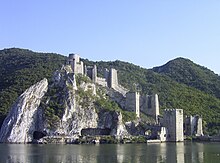Castron
Kastron ( ancient Greek κάστρον , Latin castrum ) is the name of a Byzantine "fortress city", which often replaced older urban settlement centers in the course of the 7th century.
history
In the turmoil after the Persian War of Herakleios , which came to an end in 628/29 and had severely affected the once flourishing oriental provinces of Eastern Rome (Byzantium), Islamic expansion began in the 30s of the 7th century . Syria , Aegyptus and Africa were lost, while the Slavs continued to take over the Balkans . The late Roman Empire finally came to an end as a result of this process of upheaval and the progressive Graecization of the state since Herakleios. The history of medieval Byzantium began, which also brought the end of antiquity in the east.
Most of the once prosperous Eastern Roman cities (such as Athens , Pergamon , Miletus , Sardis ) were transformed in this context into much smaller communities (if they did not perish, like several smaller cities), which only reduced to a small city center still had a fraction of the previous population and were strongly fortified. Startups were the exception.
Such fortifications, often located on hills, were called kastron (κάστρον), which is the Greek form of the Latin term castrum . At first (from around the 6th century) it was only used to designate fortresses in the border area. So let Justinian II. To Donaulimes reattach and converted the castrum Singidunum 535 at a much reduced Kastron order. In the 7th century, however , in contrast to the polis , the urban center of life in the ancient Mediterranean world , kastron stood for a garrison and fortress city. Kastra served as military bases and enabled the Byzantine troops to at least partially put a stop to the regular raids by the Arabs . This approach was quite successful: in the year 716, around 800 men defended Amorion against an Arab force ten times as large.
Hardly any civilian population lived in such kastra , although they were often also bishoprics; in times of need they also served as refuge for the surrounding population. Little is known about the internal structures, however; urban self-government, as is common in the ancient Greek and Roman cities, probably did not take place. Instead, the administration was mainly in the hands of the garrison commander, the castrophylax .
Perhaps the differences, at least to the city of late antiquity , should not be exaggerated, since such a process of change began slowly in the 5th, but at the latest in the 6th century, and urban life also changed. However, it is undeniable that there was a reduction in built-up areas and that only relatively few cities, such as Constantinople , Thessaloniki or Nicaia , retained more of their old urban substance. Some larger cities were sometimes referred to as kastron , but never the city of Constantinople.
Some kastra , such as Ankyra or Amorion (which in the 9th century was only a few hundred meters in diameter), played a central role in the Byzantine administrative system. They also became the nucleus of new urban life when a new phase of construction began in the 10th century that went beyond the old fortifications (as shown by the archaeological studies in Pergamon).
When the pressure from the Turks in Asia Minor increased at the end of the 11th century , kastra were again established, for which a special tax was even levied. In the 12th century kastra was also founded on the Balkan Peninsula . Emperor Manuel I used building material from the Hungarian Semlin, razed by the Byzantines , to fortify Greek Weißenburg (Belgrade) on the Danube border . This building activity continued in the 13th century, until the Byzantine emperors were no longer able to continue defending the border in Asia Minor in this way. The Byzantine fortresses there were conquered by the Turks until the middle of the 14th century.
The type of castron was widely used by the Slavic rulers in the Balkan Peninsula. Here the castron type was the primary city and fortification type until the 15th century. Byzantine defenses were even copied in the late medieval Serbian complex of the spacious Smederevo Castle (first half of the 15th century). Fortified monasteries like Manasija also correspond to this type. The expansion of Belgrade under Stefan Lazarević used the previous building and expanded the fortifications. Within the fortress of Belgrade , however, the upper town in particular largely corresponds to Byzantine constructions.
literature
- Wolfram Brandes : Kastron . In: Lexicon of the Middle Ages . Volume 5, Col. 1051f. (Literature)
- Archie Dunn: The transition from polis to Kastron in the Balkans (III – VII cc.): General and regional perspectives . In: Byzantine and Modern Greek Studies. Volume 17, 1994, pp. 60-80.
- John Haldon: Byzantium in the Seventh Century. The Transformation of a Culture . 2nd edition, Cambridge 1997.
- Wolfgang Müller-Wiener : From the polis to the Kastron. Changes in the city in the Aegean region from antiquity to the Middle Ages . In: Gymnasium Volume 93, 1986, pp. 435-475.

